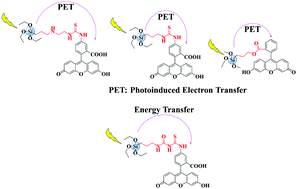Impact of the chemical nature and position of spacers on controlling the optical properties of silicon quantum dots†
Abstract
The unique properties of silicon quantum dots (SQDs), including intriguing optical properties, biocompatibility, and ease of surface modification have made them excellent candidates for a variety of optoelectronic and biomedical applications. Unfortunately, the low quantum efficiency (QE), unstable photoluminescence, and poor colloidal stability of SQDs have hindered their wide applicability. Herein, we report the synthesis of four assemblies of SQDs (1.6–1.8 nm average diameter) functionalized with fluorescein dye through isothiocyanate (–NCS) and carboxylate (COO–) spacers in the benzene ring of the fluorescein to produce the dyads Am-SQD-Fl, DiAm-SQD-Fl, urea-SQD-Fl, and SQD-Fl. The photophysical measurements showed that the spacer played a key role in directing and controlling the optical properties of SQDs dyads, with the isothiocyanate spacer leading to a significant improvement in the QE of the dyad systems up to 65% and extending their photostability for at least one year. The interactions between the SQDs and fluorescein in the dyads Am-SQD-Fl, DiAm-SQD-Fl, and SQD-Fl were found to mainly proceed through photoinduced electron transfer at different rates, while energy transfer was confirmed to be the predominant process in the dyad urea-SQD-Fl. To demonstrate the suitability of the functionalized SQDs for bioimaging applications, the water-soluble dyads were examined for fluorescence imaging of human bone cancerous U2OS cells.



 Please wait while we load your content...
Please wait while we load your content...